 W
WAdoration of the Christ Child is a 1463 tempera on panel painting by Filippo Lippi, in the Uffizi since 1919. It was last restored in 2007 by Daniele Rossi. It was first attributed to Lippi by Pudelko - he argued it was early in the artist's career due to its references to Beato Angelico's style, but Bernard Berenson later argued that these references instead placed it in a more mature phase.
 W
WAdoration of the Christ Child is a tempera on panel altarpiece by Filippo Lippi, originally painted for the church of San Domenico in Prato and now in the city's Museo Civico. It is also known as Adoration of the Christ Child with St Vincent Ferrer or Nativity with St George and St Vincent Ferrer. It was painted between 1455 and 1466. The work was probably damaged by a fire in the church in 1467, requiring some repairs which were discovered in a recent restoration of the work.
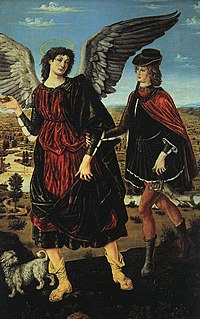 W
WThe Archangel Raphael and Tobias is a c.1465–1470 oil on panel painting by Piero del Pollaiolo, now in the Galleria Sabauda in Turin.
 W
WThe Bartolini Tondo is a tempera on panel painting by Filippo Lippi. 135 cm in diameter, it is also known as Madonna with the Child and Scenes from the Life of St Anne or Madonna and Child with the Birth of the Virgin and the Meeting between St Joachim and St Anne. It is now in the Galleria Palatina in the Palazzo Pitti in Florence - the work is mentioned in the Palazzo Pitti inventories in 1761, which mention it as being stored or displayed in the "soffitte" or attics.
 W
WThe Camera degli Sposi, sometimes known as the Camera picta, is a room frescoed with illusionistic paintings by Andrea Mantegna in the Ducal Palace, Mantua, Italy. During the fifteenth century when the Camera degli Sposi was painted, Mantua was ruled by the Gonzaga, who maintained Mantua's political autonomy from its much stronger neighbors Milan and Venice by bidding their support out as a mercenary state. Ludovico III Gonzaga, the commissioner of the Camera degli Sposi was the ruler of Mantua at the time. He, trained as a professional soldier, was looking to give the Gonzaga rule more cultural credibility with his commissioning of Andrea Mantegna in a humanist Renaissance political landscape in which other courts such as the Ferrara were commissioning their own “painted chambers”.
 W
WCharity is a 1469 oil on panel painting by Piero del Pollaiolo, now in the Uffizi in Florence.
 W
WChrist Blessing is a tempera on panel painting by Giovanni Bellini. It is usually dated to the early 1460s, that is, in the middle of Bellini's Mantegnese phase. It is now in the Louvre in Paris.
 W
WThe Death of the Virgin is a painting by the Italian Renaissance painter Andrea Mantegna, from c. 1462–1464.
 W
WCrucifixion Diptych — also known as Philadelphia Diptych, Calvary Diptych, Christ on the Cross with the Virgin and St. John, or The Crucifixion with the Virgin and Saint John the Evangelist Mourning — is a diptych by the Early Netherlandish artist Rogier van der Weyden, completed c. 1460, today in the Philadelphia Museum of Art. The panels are noted for their technical skill, visceral impact and for possessing a physicality and directness unusual for Netherlandish art of the time. The Philadelphia Museum of Art describes work as the "greatest Old Master painting in the Museum."
 W
WDead Christ Supported by Two Angels is a painting by Italian Renaissance painter Giovanni Bellini, created around 1460. It is housed in the Museo Correr in Venice.
 W
WDeath of the Virgin is a 1460–65 painting by Petrus Christus.
 W
WThe Death of the Virgin is a painting by the Italian Renaissance painter Andrea Mantegna, from c. 1462–1464.
 W
WThe Ferrara Cathedral Organ Case was a set of 1469 tempera on canvas paintings by Cosme Tura, originally forming doors for the organ at Ferrara Cathedral but now in the cathedral museum. Originally double-sided, the front and back of each door have now been separated. As originally constructed, the doors showed an annunciation scene when open and Saint George and the Princess when closed.
 W
WThe Greek Madonna is a 1460–1470 tempera on panel painting by Giovanni Bellini. It is named after the Greek monograms at top left and top right and after the major influence of Byzantine icons on the painting. The Christ Child holds a golden apple, perhaps referring to the Judgement of Paris and to Mary as the "new Venus".
 W
WThe head of St. John the Baptist is a tondo painting by the Italian Renaissance master Giovanni Bellini. It is now housed in the Civic Museum of Pesaro.
 W
WThe History of the True Cross or The Legend of the True Cross is a sequence of frescoes painted by Piero della Francesca in the Basilica of San Francesco in Arezzo. It is his largest work, and generally considered one of his finest, and an early Renaissance masterpiece.
 W
WThe Lamentation of Christ is an oil-on-panel painting of the common subject of the Lamentation of Christ by the Netherlandish artist Rogier van der Weyden, dating from around 1460–1463 and now in the Uffizi Gallery, Florence, Italy.
 W
WMadonna with Child is a painting by the Italian Renaissance artist Filippo Lippi. The date in which it was executed is unknown, but most art historians agree that it was painted during the last part of Lippi's career, between 1450 and 1465. It is one of the few works by Lippi which was not executed with the help of his workshop and was an influential model for later depictions of the Madonna and Child, including those by Sandro Botticelli. The painting is housed in the Uffizi Gallery, Florence, Italy, and is therefore commonly called “The Uffizi Madonna” among art historians.
 W
WThe Madonna and Child with an Angel is a painting by the Italian Renaissance painter Sandro Botticelli, c. 1465–1467. It is housed in Spedale degli Innocenti of Florence.
 W
WA Madonna del Parto is an iconic depiction of the Virgin Mary shown as pregnant, which was developed in Italy, mainly in Tuscany in the 14th century. Examples include works by Taddeo Gaddi, Bernardo Daddi and Nardo di Cione, but the fresco by Piero della Francesca is considered the most famous one. The Madonna was portrayed standing, alone, often with a closed book on her belly, an allusion to the Incarnate Word. The works were associated with the devotions of pregnant women, praying for a safe delivery. Sometimes, as with a statue by Sansovino in the Basilica of Sant'Agostino in Rome, the depiction is of a Virgin and Child, but known as a Madonna del Parto because it was especially associated with devotions over pregnancy. Here the Virgin wears the Girdle of Thomas, a belt of knotted cloth cord that was a relic held in Prato Cathedral, which many depictions wear.
 W
WThe Madonna of Palazzo Medici-Riccardi is a painting by the Italian Renaissance artist Filippo Lippi. It is housed in the Palazzo Medici-Riccardi of Florence, central Italy.
 W
WThe Madonna of the Zodiac is a c.1459-1463 tempera on panel painting by Cosmè Tura, named after the partly-lost gold outline of a zodiac behind the Madonna, alluding to Christ's role as "chronocrator". It is now in the Gallerie dell'Accademia in Venice.
 W
WThe Magi Chapel is a chapel in the Palazzo Medici Riccardi of Florence, Italy. Its walls are almost entirely covered by a famous cycle of frescoes by the Renaissance master Benozzo Gozzoli, painted around 1459 for the Medici family, the effective rulers of Florence.
 W
WThe Medici Madonna is an oil-on-panel painting by the Netherlandish artist Rogier van der Weyden, dating from around 1460–1464 and housed in the Städel, Frankfurt, Germany.
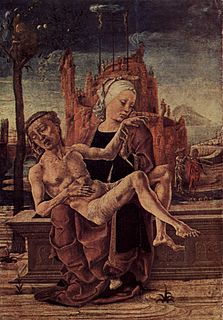 W
WPietà is a tempera on panel painting by Cosmè Tura, measuring 47.7 cm by 33.5 cm. It is now in the Museo Correr in Venice, to which it was left with the rest of the collection of Teodoro Correr on 1 January 1830. It was attributed to Luca d'Olanda until 1859, when Vincenzo Lazari recognised it as a work by Tura. By comparison with the same artist's Calliope and his Roverella Altarpiece, it has been dated to the 1460s.
 W
WThe Polyptych of the Misericordia is a painting conserved in the Museo Civico di Sansepolcro in the town of Sansepolcro, region of Tuscany, Italy. The painting is one of the earliest works of the Italian Renaissance painter Piero della Francesca, who was born in the town. The central panel is of the common motif of the Virgin of Mercy or Madonna della Misericordia.
 W
WPortrait of a Lady is a small oil-on-oak panel painting executed around 1460 by the Netherlandish painter Rogier van der Weyden. The composition is built from the geometric shapes that form the lines of the woman's veil, neckline, face, and arms, and by the fall of the light that illuminates her face and headdress. The vivid contrasts of darkness and light enhance the almost unnatural beauty and Gothic elegance of the model.
 W
WPortrait of a Man is a painting attributed to the Italian Renaissance artist Andrea Mantegna. It is housed in the National Gallery of Art, Washington, DC, United States.
 W
WPortrait of a Young Girl is a small oil-on-oak panel painting by the Early Netherlandish painter Petrus Christus. It was completed towards the end of his life, between 1465 and 1470, and is held in the Gemäldegalerie, Berlin. It marks a major stylistic advance in contemporary portraiture; the girl is set in an airy, three-dimensional, realistic setting, and stares out at the viewer with a complicated expression that is reserved, yet intelligent and alert.
 W
WPortrait of Antoine, 'Grand Bâtard' of Burgundy is an oil panel painting by the Netherlandish painter Rogier van der Weyden portraying Anthony of Burgundy, the bastard son of Philip the Good and one of his mistresses, Jeanne de Presle. The panel is dated to about 1460 and held in the Royal Museums of Fine Arts of Belgium, Belgium. He wears the livery collar of Order of the Golden Fleece, a chivalric order established January 10, 1430, by Philip the Good, Duke of Burgundy. In 1456 Anthony was inducted into the prestigious Order, held by only 29 others at that time. The exact significance of the arrow held in the bastard's hand is unknown, although the fleece is thought to refer to either the Greek mythological hero Jason or the Hebrew warrior and judge Gideon.
 W
WThe Portrait of Carlo de' Medici is a painting by the Italian Renaissance master Andrea Mantegna, executed in 1466. It is now housed in the Uffizi Gallery of Florence.
 W
WProfile of a Man or Male Portrait is a tempera on panel painting, Museo Poldi Pezzoli in Milan. It is attributed to Andrea Mantegna, though its dating and attribution are uncertain. Some have attributed it to Cosmè Tura, Francesco Bonsignori and others, though it is now more usually attributed to Mantegna, either from his stay in Ferrara in 1448-50 or from his arrival in Mantua in 1460. The subject is unknown, though his costume and hat suggest a Venetian magistrate, a lawyer or a nobleman.
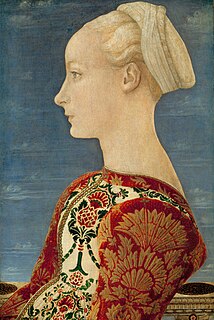 W
WProfile Portrait of a Young Lady is a 1465 half-length portrait, made with oil-based paint and tempera on a poplar panel. It is held by the Gemäldegalerie in Berlin, which describes this work as one of its most famous paintings, and as one of the most famous portraits of women from the early Italian Renaissance.
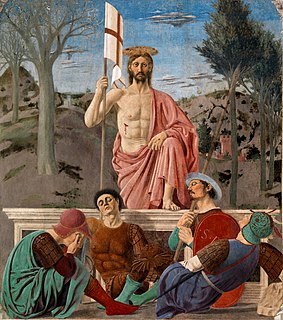 W
WThe Resurrection is a fresco painting by the Italian Renaissance master Piero della Francesca, painted in the 1460s in the Palazzo della Residenza in the town of Sansepolcro, Tuscany, Italy.
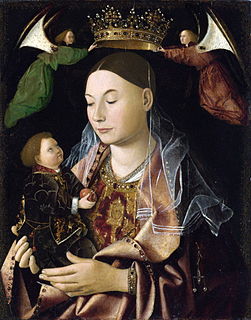 W
WThe Madonna with Child is a painting attributed on basis of style to the early Italian Renaissance master Antonello da Messina, depicting the Madona holding the doll-like Child and wearing an ornate golden crown, held by angels over her head. It is housed in the National Gallery, London. The name Salting, which is also applied to a Madonna by Robert Campin, denotes George Salting, the collector who donated it to the gallery in 1910.
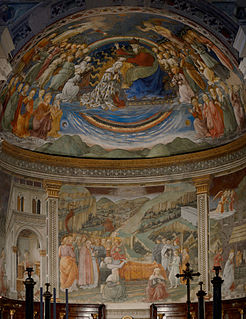 W
WScenes from the Life of the Virgin Mary is a cycle of frescos by Filippo Lippi in Spoleto Cathedral.
 W
WThe Stories of St. Stephen and St. John the Baptist is a fresco cycle by the Italian Renaissance painter Filippo Lippi and his assistants, executed between 1452 and 1465. It is located in the Great Chapel of the Cathedral of Prato, Italy.